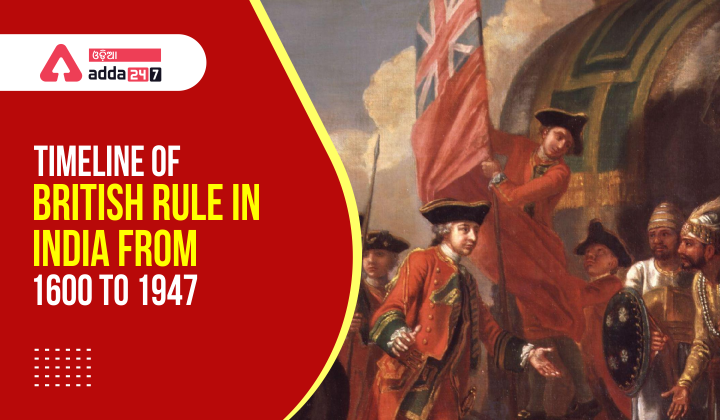ବ୍ରିଟିଶ ଇଷ୍ଟ ଇଣ୍ଡିଆ କମ୍ପାନୀ 1600 ମସିହାରେ ଗଠିତ ହୋଇଥିଲା ଏବଂ 1858 ପର୍ଯ୍ୟନ୍ତ ଭାରତକୁ ଶାସନ କରି ଶେଷ କରିଥିଲା, ଯେଉଁଠାରେ ବ୍ରିଟିଶ କ୍ରାଉନ୍ ଦାୟିତ୍ ଗ୍ରହଣ କରିଥିଲା। ବ୍ରିଟିଶ ରାଜ 1947 ପର୍ଯ୍ୟନ୍ତ ଚାଲିଥିଲା, ଯେତେବେଳେ ଭାରତ ଏବଂ ପାକିସ୍ଥାନ ସ୍ଵୟଂ ଶାସିତ ହେଲେ।
ବ୍ରିଟିଶ ରାଜ ଅଧୀନରେ ବ୍ରିଟିଶମାନେ ସ୍ଥାନୀୟ ଭାରତୀୟ ରାଜକୁମାରଙ୍କ ସାହାଯ୍ୟରେ ଭାରତକୁ ଶାସନ କରିଥିଲେ, ଯେଉଁମାନେ ବ୍ରିଟିଶମାନଙ୍କ ପ୍ରତି ବିଶ୍ୱସ୍ତ ରହି ଉପକୃତ ହୋଇଥିଲେ। ଅବଶ୍ୟ, ବ୍ରିଟିଶ ଶାସନର ଅଧିକାଂଶ ଲାଭ ବ୍ରିଟିଶ ନାଗରିକଙ୍କ ଏକ ଛୋଟ ଉପର ଶ୍ରେଣୀକୁ ଯାଇଥିବାବେଳେ ସାଧାରଣ ଭାରତୀୟ ଏକ ନିମ୍ନ ଶ୍ରେଣୀରେ ରହୁଥିଲେ ଏବଂ ଅନେକ ସମୟରେ ଜୀବନ ଉପରେ ଅତ୍ୟାଚାର କରୁଥିଲେ। (ଉତ୍ସ: ଜାତୀୟ ଅଭିଲେଖାଗାର: ବ୍ରିଟିଶ ସାମ୍ରାଜ୍ୟରେ ବାସ କରିବା)
ଭାରତରେ ବ୍ରିଟିଶ ଶାସନର ଅନେକ ଭୁଲ କାର୍ଯ୍ୟ ମଧ୍ୟରେ ଇତିହାସ ସମଗ୍ର ଦେଶକୁ କଳାଧନରୁ ବଞ୍ଚିତ କରୁଥିବା କାର୍ଯ୍ୟକୁ ଦେଖିବ। -ମହତମା ଗାନ୍ଧୀ |
British India Timeline
ସମୟସୀମା ବର୍ଣ୍ଣନା: ସପ୍ତଦଶ ଶତାବ୍ଦୀର ପ୍ରାରମ୍ଭରେ ଯେତେବେଳେ ଭାରତରେ ବ୍ରିଟିଶ ଉପସ୍ଥିତି ଆରମ୍ଭ ହୋଇଥିଲା, ଯେତେବେଳେ ବ୍ରିଟିଶ ଇଷ୍ଟ ଇଣ୍ଡିଆ କମ୍ପାନୀ ମୋଗଲ ସାମ୍ରାଜ୍ୟର ବାହାରେ ବାଣିଜ୍ୟ ଆରମ୍ଭ କରିଥିଲା। କମ୍ପାନୀର ପ୍ରଭାବ ସ୍ଥିର ଭାବରେ ବୃଦ୍ଧି ପାଇଲା ଯେପର୍ଯ୍ୟନ୍ତ ଏହା ଭାରତର କିଛି ଅଂଶର ରାଜନିତିକ ନିୟନ୍ତ୍ରଣକୁ ନଆସିଲା ଏବଂ ବ୍ରିଟିଶ ନେତାମାନେ ଉପମହାଦେଶରେ ବ୍ରିଟିଶ ନିୟନ୍ତ୍ରଣ ବିସ୍ତାର କରିବାରେ ଲାଗିଲେ। ଯଦିଓ ଉନବିଂଶ ଶତାବ୍ଦୀରେ ନିୟନ୍ତ୍ରଣ ବ୍ରିଟିଶ ମୁକୁଟକୁ ସ୍ଥାନାନ୍ତରିତ ହୋଇଥିଲା, ଭାରତୀୟମାନେ ଏକ ଶକ୍ତିଶାଳୀ ଜାତୀୟତାବାଦୀ ଆନ୍ଦୋଳନ ଆରମ୍ଭ କରିଥିଲେ ଯାହା 1947 ମସିହାରେ ବ୍ରିଟେନରୁ ସ୍ୱାଧୀନତା ଆଣିଥିଲା।
ବ୍ରିଟେନ ଏବଂ ଏହାର ପୂର୍ବ ରାଜ୍ୟଗୁଡିକ ଦ୍ୱାରା ପରିଚାଳିତ କିମ୍ବା ପରିଚାଳିତ ଶାସନ, ଉପନିବେଶ, ସଂରକ୍ଷଣ, ଆଦେଶ ଏବଂ ଅନ୍ୟାନ୍ୟ ଅଞ୍ଚଳକୁ ବ୍ରିଟିଶ ସାମ୍ରାଜ୍ୟ ଗଠିତ କରିଥିଲା | ଏହା ୧th ଶତାବ୍ଦୀର ଶେଷ ଭାଗରୁ ଅଷ୍ଟାଦଶ ଶତାବ୍ଦୀର ଆରମ୍ଭରେ ଇଂଲଣ୍ଡ ଦ୍ୱାରା ପ୍ରତିଷ୍ଠିତ ବିଦେଶୀ ସମ୍ପତ୍ତି ଏବଂ ବାଣିଜ୍ୟ ପୋଷ୍ଟ ସହିତ ଆରମ୍ଭ ହୋଇଥିଲା | ଏହାର ଉଚ୍ଚତାରେ ଏହା ଇତିହାସର ସବୁଠାରୁ ବଡ ସାମ୍ରାଜ୍ୟ ଥିଲା ଏବଂ ଏକ ଶତାବ୍ଦୀରୁ ଅଧିକ ସମୟ ଧରି ସର୍ବଭାରତୀୟ ଶକ୍ତି ଥିଲା |
ପଞ୍ଚଦଶ ଏବଂ ଷୋଡଶ ଶତାବ୍ଦୀରେ ଆବିଷ୍କାର ଯୁଗରେ, ପର୍ତ୍ତୁଗାଲ ଏବଂ ସ୍ପେନ୍ ପୃଥିବୀର ୟୁରୋପୀୟ ଅନୁସନ୍ଧାନରେ ଅଗ୍ରଗତି କରିଥିଲେ ଏବଂ ଏହି ପ୍ରକ୍ରିୟାରେ ବୃହତ ବିଦେଶ ସାମ୍ରାଜ୍ୟ ପ୍ରତିଷ୍ଠା କରିଥିଲେ | ଏହି ସାମ୍ରାଜ୍ୟଗୁଡିକ ସୃଷ୍ଟି କରିଥିବା ବହୁ ଧନ ପ୍ରତି ବର୍ଷା କରି ଇଂଲଣ୍ଡ, ଫ୍ରାନ୍ସ ଏବଂ ନେଦରଲ୍ୟାଣ୍ଡ ଆମେରିକା ଏବଂ ଏସିଆରେ ନିଜର ଉପନିବେଶ ଏବଂ ବାଣିଜ୍ୟ ନେଟୱାର୍କ ପ୍ରତିଷ୍ଠା କରିବାକୁ ଲାଗିଲେ |
ଆମେରିକାର ସଂଗ୍ରାମ ଦ୍ୱାରା ବ୍ରିଟେନ 1783 ସୁଦ୍ଧା ଉତ୍ତର ଆମେରିକାର କେତେକ ପୁରାତନ ତଥା ଜନବହୁଳ ଉପନିବେଶ ହରାଇଲା। ବ୍ରିଟିଶଙ୍କ ଧ୍ୟାନ ଏସିଆ, ଆଫ୍ରିକା ଏବଂ ପ୍ରଶାନ୍ତ ମହାଦେଶ ଆଡକୁ ଗଲା। ନାପୋଲେଓନିକ୍ ଯୁଦ୍ଧରେ (1803–1815) ଫ୍ରାନ୍ସର ପରାଜୟ ପରେ ବ୍ରିଟେନ 19th ନବିଂଶ ଶତାବ୍ଦୀର ମୂଖ୍ୟ ନୈସେନା ତଥା ସାମ୍ରାଜ୍ୟ ଶକ୍ତି ଭାବରେ ଉଭା ହେଲା ଏବଂ ଏହାର ସାମ୍ରାଜ୍ୟ ଧାରଣକୁ ବିସ୍ତାର କଲା | ଆପେକ୍ଷିକ ଶାନ୍ତିର ଅବଧି (1803–1815) ଯେଉଁଥିରେ ବ୍ରିଟିଶ ସାମ୍ରାଜ୍ୟ ସର୍ବଭାରତୀୟ ହେଗମୋନରେ ପରିଣତ ହୋଇଥିଲା ପରେ ଏହାକୁ “ପ୍ୟାକ୍ସ ବ୍ରିଟାନିକା” (“ବ୍ରିଟିଶ ଶାନ୍ତି”) ଭାବରେ ବର୍ଣ୍ଣନା କରାଯାଇଥିଲା |
ଯେତେବେଳେ ଇଂଲଣ୍ଡ ଏବଂ ସ୍କଟଲ୍ୟାଣ୍ଡ ଅଲଗା ରାଜ୍ୟ ଥିଲେ ସେତେବେଳେ ବ୍ରିଟିଶ ସାମ୍ରାଜ୍ୟର ମୂଳଦୁଆ ପକାଯାଇଥିଲା | 1496 ମସିହାରେ, ଇଂଲଣ୍ଡର ରାଜା ହେନେରୀ ସପ୍ତମ, ବିଦେଶ ଅନୁସନ୍ଧାନରେ ସ୍ପେନ୍ ଏବଂ ପର୍ତ୍ତୁଗାଲର ସଫଳତା ପରେ ଜନ୍ କ୍ୟାବୋଟଙ୍କୁ ଉତ୍ତର ଆଟଲାଣ୍ଟିକ୍ ଦେଇ ଏସିଆକୁ ଉତ୍ତର-ପଶ୍ଚିମ ପଥ ଆବିଷ୍କାର କରିବା ପାଇଁ ଏକ ଅଭିଯାନର ନେତୃତ୍ୱ ନେବାକୁ ନିର୍ଦ୍ଦେଶ ଦେଇଥିଲେ |
Rivalry with other European empires
ଷୋଡଶ ଶତାବ୍ଦୀର ଶେଷରେ, ଇଂଲଣ୍ଡ ଏବଂ ଡଚ୍ ସାମ୍ରାଜ୍ୟ ପର୍ତ୍ତୁଗୀଜ୍ ସାମ୍ରାଜ୍ୟର ଏସିଆ ସହିତ ବାଣିଜ୍ୟର ଏକଚାଟିଆତାକୁ ଚ୍ୟାଲେଞ୍ଜ କରିବାକୁ ଲାଗିଲେ ଏବଂ ଏହି ଯାତ୍ରା ପାଇଁ ଅର୍ଥ ପ୍ରଦାନ ପାଇଁ ଘରୋଇ ଯୁକ୍ତ ଷ୍ଟକ୍ କମ୍ପାନୀ ଗଠନ କଲେ – ଇଂରାଜୀ, ପରେ ବ୍ରିଟିଶ୍, ଇଷ୍ଟ ଇଣ୍ଡିଆ କମ୍ପାନୀ ଏବଂ ଡଚ୍ ପୂର୍ବ ଭାରତ କମ୍ପାନୀ, ଯଥାକ୍ରମେ 1600 ଏବଂ 1602 ରେ ଚାର୍ଟାର୍ଡ | ଏହି କମ୍ପାନୀଗୁଡିକର ମୂଳ ଲକ୍ଷ୍ୟ ଥିଲା ଲାଭଜନକ ମସଲା ବାଣିଜ୍ୟକୁ ଟ୍ୟାପ୍ କରିବା, ଏକ ପ୍ରୟାସ ମୁଖ୍ୟତ ଦୁଇଟି ଅଞ୍ଚଳ ଉପରେ ଧ୍ୟାନ ଦିଆଯାଇଥିଲା: ଇଷ୍ଟ ଇଣ୍ଡିଜ୍ ଦ୍ୱୀପପୁଞ୍ଜ ଏବଂ ବାଣିଜ୍ୟ ନେଟୱାର୍କ, ଭାରତର ଏକ ଗୁରୁତ୍ୱପୂର୍ଣ୍ଣ ହବ୍ | ସେଠାରେ, ସେମାନେ ପର୍ତ୍ତୁଗାଲ ଏବଂ ପରସ୍ପର ସହିତ ବାଣିଜ୍ୟ ସର୍ବୋଚ୍ଚତା ପାଇଁ ପ୍ରତିଦ୍ୱନ୍ଦ୍ୱିତା କଲେ |
ବ୍ରିଟିଶ ସାମ୍ରାଜ୍ୟ ଏହାର ବ୍ୟାପକ, ଦୀର୍ଘସ୍ଥାୟୀ ଏବଂ ସୁଦୂରପ୍ରସାରୀ ସାମ୍ରାଜ୍ୟ କାର୍ଯ୍ୟକଳାପ ପାଇଁ ସ୍ମରଣୀୟ ଅଟେ ଯାହା ଜଗତୀକରଣ ଏବଂ ସଂଯୋଗର ଏକ ଯୁଗ ଆରମ୍ଭ କରିଥିଲା | ବ୍ରିଟିଶ ସାମ୍ରାଜ୍ୟ ଷୋଡଶ ଶତାବ୍ଦୀରେ ଏହାର ଗଠନ ବର୍ଷରେ ଆରମ୍ଭ ହୋଇଥିଲା ଏବଂ ନାଟକୀୟ ଭାବରେ ବୃଦ୍ଧି ପାଇଲା ଏବଂ ବିଂଶ ଶତାବ୍ଦୀ ପର୍ଯ୍ୟନ୍ତ ରହିଲା |
| Date | Event |
| 1617 | The British East India Company wins trading rights in the Mughal empire.
Hoping to make money trading with India, the British East India Company wins trading rights on the fringe of the Mughal empire in 1617. As the Mughal empire declines, the East India Company’s influence in India grows steadily. |
| June 23, 1757 | The East India Company takes political control in India.
On June 23, 1757, Robert Clive leads a British military force to victory at Plassey against the Nawab of Bengal. As a result, the East India Company takes political control over a large swath of India, despite its background as a trading company. |
| 1773 | Governor-General Warren Hastings consolidates control in India.
Warren Hastings becomes the first Governor-General of India in 1773, a position he holds until 1784. Hastings works quickly to consolidate the East India Company’s control in India, removing power from the Nawab of Bengal and crippling the Mughal Empire. Hastings wages war and forms alliances to increase Britain’s control. While he hopes to introduce Britain to Indian history and culture, his successors launch decades of “reforms” meant to westernize the subcontinent. |
| 1822 | Ram Mohun Roy sparks Indian nationalism.
The scholar Ram Mohun Roy, educated in both Western and Eastern classics, believes that India can learn from the West, but that there is room for a revitalization of Indian culture. In 1822 he sets up educational societies that help revive pride in Indian culture, and his influence on later leaders places him as the founder of Indian nationalism. |
| May 10, 1857 | The Sepoy Rebellion breaks out in India.
The East India Company requires sepoys, or Indian soldiers serving the company, to bite off cartridges greased with animal fat to load their rifles. The animal fat is from cows, which are sacred to Hindus, or from pigs, which are forbidden to Muslims, and angry sepoys rise up in rebellion against their British officers. After brutal massacres on both sides, the British quell the rebellion, but an atmosphere of hatred and distrust remains. |
| August 2, 1858 | Parliament puts India directly under control of the British crown.
After the Sepoy Rebellion, Parliament ends the rule of the East India Company and places India directly under control of the British crown. India is now governed by colonial rule, with British officials ruling in the name of the queen and holding top positions. Britain slows the reforms that so angered Hindus and Muslims, but continues to develop India for its own economic benefit. |
| November 17, 1869 | The Suez Canal opens and greatly improves British trade.
On November 17, 1869, the Suez Canal opens, and British trade with India greatly increases. The system favors the British, who flood India with inexpensive, machine-made textiles. This destroys India’s once-prosperous hand-weaving industry. |
| December 28, 1885 | The Indian National Congress is organized.
Nationalist leaders organize the Indian National Congress in 1885, calling for greater democracy to empower professional Indians like themselves. Known as the Congress party, the group hopes to use peaceful protest to achieve its goals. Members support modernization on a western model, but their ultimate dream is to achieve Indian self-rule. |
| December 30, 1906 | The Muslim League is organized.
Resenting Hindu domination of the Congress party, Muslims form the Muslim League in 1906 to pursue their goals of independence and democracy. They fear that a Hindu-run government would oppress Muslims, and they begin to form plans for a separate Muslim state. |
| April 13, 1919 | The Amritsar massacre spurs the call for independence.
After World War I, Indians are growing increasingly frustrated that they fought for Britain but still have no freedom in their own land. On April 13, 1919, British General Reginald Dyer fires on a peaceful public meeting in Amritsar, in northern India. The resulting massacre convinces many Indians that they need independence from Britain. |
| 1920 | Mahatma Gandhi launches a campaign of noncooperation(Summer 1920).
Following the Amritsar massacre, Indian lawyer Mahatma Gandhi launches a two-year campaign of noncooperation. He encourages Indians to leave British institutions, return British honors, and practice self-reliance. While Gandhi is forced to stop the campaign upon his arrest and imprisonment in 1922, he goes on to become the most recognized leader of the Indian nationalist movement. |
| March 12, 1930 | Gandhi begins the Salt March.
Aiming to raise mass support for Indian nationalism, Gandhi decides to end the British monopoly on salt. Indians are forbidden to touch any salt not sold by the British government, so Gandhi organizes a march to the sea. Gandhi and his followers begin their Salt March on March 12, 1930, and after they successfully reach the sea on April 6, the salt campaign grows exponentially. |
| September 3, 1939 | World War II postpones further action on independence.
When World War II breaks out in 1939, Britain postpones further action on independence and brings India into the war without consulting them. This outrages Indian leaders, who begin a campaign of noncooperation. While the nationalist leaders are arrested, millions of Indians support Britain during the war. |
| June 1947 | Britain agrees to grant India independence.
After World War II, Britain finally agrees to grant India independence. However, the Muslim League, led by Muhammad Ali Jinnah, insists that the Muslim minority have its own separate state, Pakistan. Britain decides to partition the subcontinent into two states: Muslim Pakistan and Hindu India. |
| August 14,1947 | The partition of India causes mass migration(August 14 – 15, 1947).
While Britain agrees to partition the subcontinent into two states, Hindus and Muslims live side-by-side, making migration inevitable. When Pakistan and India are formally created in 1947, millions of Hindus and Muslims cross the borders in both directions. Centuries of mistrust between religious groups cause violence to explode in northern India. Nevertheless, India has finally gained independence from Britain. |








